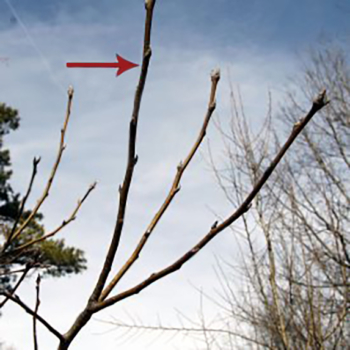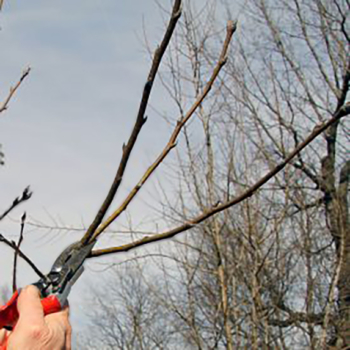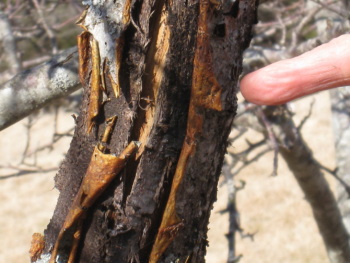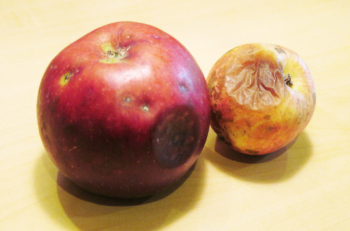Pruning for Organic Management of Fruit Tree Diseases
By Guy K. Ames, NCAT Horticulture Specialist
Abstract
This publication explains why pruning is an especially important disease-management tool for organic tree fruit growers. It explains how to remove diseased wood and prune branches and discusses how this can control spread of disease and help prevent hosting of pathogens that cause rot. Pruning strategies for apples and pears are contrasted with techniques used for other stone fruits, such as plums, peaches, and cherries.
Table of Contents
- Introduction: Let the Sunshine In
- Diseased Wood: Low-Hanging Fruit
- Pruning for Sunlight and Air
- Fire Blight of Apples and Pears
- Black Rot and Other “Summer Rots” of Apples
- Pruning Other Fruit Trees for Disease Control
- Summary
Introduction: Let the Sunshine In
Properly pruning fruit trees has more than one benefit for the plants and the grower, but, arguably, the most important benefit for organic growers is management of diseases. The organic grower has available only a fraction of the disease-suppressive spray products that a conventional grower can use. Consequently, knowing that proper pruning can aid in disease management is especially important to organic growers.
Why is this so? The answer begins with an understanding of the pathogens that incite the diseases. Practically speaking, nearly all economically important bacterial and fungal fruit pathogens rely on water to increase, spread, and infect (this is not true of most viral pathogens). And this water almost always comes in the form of rain, though overhead irrigation and very heavy dews can also contribute. Proper pruning should open the plant to wind and sun penetration, allowing for rapid drying of leaf, stem, and fruit surfaces. Without water on those surfaces, pathogens generally cannot infect the tissues. Indeed, without water on those surfaces, most pathogens cannot long survive.
Rain provides the proper conditions for a pathogen to proceed in its life cycle. If a spore has already infected tissue, the rain may provide the necessary environment to produce fruiting bodies, like mushrooms in the case of most fungi. Some of these are not mushrooms that most of us would recognize; in fact, most are too small to be visible to the naked human eye at all. Still, these fruiting bodies perform the same function that a common mushroom performs: they produce and release spores to spread into the environment, where they can land on other suitable hosts.
Some of these plant pathogens produce fruiting bodies that can project or propel spores into the environment. For instance, when spring temperatures and moisture are conducive, the fungus that incites apple scab, Venturia inaequalis, can shoot spores up into the air from a specialized organ (a pseudothecia) that overwinters on fallen leaves and fruit. Once airborne, the spores are carried by wind and blowing rain to fresh leaves and young fruit.
Tree Fruits: Organic Production Overview
In other cases, especially where the overwintering form of the fungus or bacteria is already up in the tree, simple blowing rain is the major means of spread.
Diseased Wood: Low-Hanging Fruit
The simplest and most direct way that pruning contributes to disease management in orchards is through cutting out visibly diseased wood that could otherwise be a source of reinfection. This might be fire blight strikes in pears, black rot cankers in apples, or cytospora canker in peaches and plums. For these and other diseases, a simple but very important first step in pruning is removing the obvious diseased and damaged wood. In most cases, it’s important to destroy or otherwise remove this wood from the orchard, because the offending pathogen is likely still on or in the wood in some form and still infectious.
Pruning for Sunlight and Air
Sunlight and dry air are two of the most fungicidal and bactericidal factors you can employ in your orchard. In addition to depriving fungi and bacteria of the water necessary to increase and infect, light radiation can be directly fungicidal and bactericidal. And though not directly lethal to fungi and bacteria, a drying wind denies fungi and bacteria the necessary moisture to complete their life cycles. Therefore, without sacrificing other horticultural and economic principles, whatever the orchardist can do to open the plant to sun and wind will be beneficial.
In pruning, the type of cut can make a large difference in whether you open the tree to sunlight and air or inadvertently create a “witches broom” that will block sunlight and air. To see the difference, it is necessary to understand the tree’s response to two different kinds of cuts. A “thinning cut” removes a shoot or branch all the way back to where it originated or joins with another shoot or branch, effectively removing that shoot or branch. In contrast, a “heading cut” simply cuts back part of a shoot but doesn’t remove it. See the illustrations in Photos 2 through 4.
A heading cut induces the buds below it to become active and send out new growth. The buds closest to the cut exhibit this response more than those further away from the cut. It’s as if all the vigor and life in the removed wood is suddenly forced out through the remaining buds. This can actually be useful, especially with young trees: pinch or cut back the top bud or more of a young whip, and the buds under it will begin growing, providing the grower choices for scaffold branches. You can essentially decide where your first branches will start (how high up on the trunk) by cutting the whip back to that height.
However, with an older, fruiting tree, heading cuts too often result in a profusion of shoot growth emanating from the buds just below the site of the cut. This does nothing to help sunlight and wind penetrate into the interior of the tree.
A thinning cut results in a different response. First, and most importantly for our purposes, it does NOT promote a flush of shoot growth from multiple buds below the cut. To the contrary, with thinning cuts, it’s as if all the life and vigor represented in the removed shoot is redistributed throughout the tree. In fact, a moderate or heavy pruning with a lot of thinning cuts will result in a more open tree, but the remaining shoots will be invigorated. This is what we want to have happen (but too much can result in soft, overly-vigorous shoots that are especially easy for the fire blight bacteria to penetrate—more on this in the section on fire blight).
Fire Blight of Apples and Pears
Once fire blight infection has occurred, there is no spray or other treatment, beyond quickly cutting or breaking out newly infected limbs, that will minimize damage. However, infection has almost certainly extended beyond what the grower sees; therefore, it is all too easy to spread the disease by trying to prune it out during the growing season. If you do cut during the growing season, remove all blighted twigs, branches, and cankers at least eight inches—some sources recommend 12 inches—below the last point of visible infection, and burn them. After each cut, the shears can be sterilized in alcohol or Lysol® solution (one part household bleach or Lysol to four parts water) to help avoid transmitting the disease from one branch to another. Lysol is less corrosive than bleach to the metal parts of the pruners. If you have more than a few branches to cut out, it can be convenient to use a spray can of Lysol disinfectant carried in an apron, rather than a plastic holster or glass jar with a liquid solution. Some research has indicated that pruner sterilization is pointless, because infection has so often proceeded beyond the point where it is visible. Another option, then, to eliminate the sterilization step is to simply break out the fire blight strike with your hands where possible.

Branch to be pruned. Photo: Robyn Metzger, NCAT

A heading cut removes just part of the branch, leaving buds below the cut. Photo: Robyn Metzger, NCAT

A thinning cut removes the branch completely. Photo: Robyn Metzger, NCAT
During the winter, when the temperature renders the bacteria inactive, pruning out fire blight-infected wood can proceed without sterilization of pruning tools and need not extend as far below the visible canker, though it is still recommended to go six to eight inches below the last visible sign of infection before you cut.
The truly tricky aspect of removing fire blighted wood is knowing when enough is enough. Remember, anything that invigorates the tree can result in soft, rapidly growing shoots that are especially vulnerable to blight infection. And pruning, in general, invigorates the tree. If blight is severe, you could do more harm by removing too much wood, especially early in the growing season. At some point, if there is a lot of blight in your planting and conditions are favorable for blight (growth is vigorous, lots of rain, warm), it could actually be the best decision to simply wait until mid-summer or, better yet, dormancy to remove the affected wood. Such a decision is as much art as science and the pruner must weigh several factors—variety, the weather forecast, vigor or lack of it in the tree, expected fruit load (a heavy crop will slow down growth), history of blight in any given tree, etc.—before beginning.
All in all, though, research indicates that getting that blighted wood out of the orchard is important, so if in doubt, cut it out!
The same factors that the pruner must consider with regard to pruning trees actually showing fire blight must also be considered when pruning almost any apple or pear tree, with the possible exception of those in orchards that have never shown any fire blight. Otherwise, always keep in mind that over-pruning can predispose apple and pear trees to infection by the fire blight pathogen.
Black Rot and Other “Summer Rots” of Apples
The fungal pathogens that incite black rot, bitter rot, and white rot on apples overwinter on cankers that may have been the result of winter damage, fire blight, or previous damage by the fungi themselves. Though there are three different pathogens that cause these summer rots, their life cycles are all similar insofar as they often overwinter on damaged wood. The long canker in Photo 5, regardless of its original cause, is the type of canker that often harbors the overwintering spore forms. The damaged limb in Photo 6 is likely the result of a bark infection by Botryo-sphaeria obtusa, the fungal pathogen that causes black rot. The rotten fruit below was likely first infected by spores coming from limb cankers like those depicted in photos 5 and 6. Obviously, such cankers must be cut out and destroyed or removed from the orchard environment.

Cankered limb. Original cause of the canker is unknown, but such cankers are often overwintering sites for pathogens that cause summer rots. Photo: Guy K. Ames, NCAT

Bark damage probably caused by B. obtusa, the causal organism of black rot. Such damage should be pruned out of trees, and the infected limbs destroyed. Photo: Guy K. Ames, NCAT

Summer rots on fruit. Photo: Guy K. Ames, NCAT
Pruning Other Fruit Trees for Disease Control
Because of their need for apical dominance and because of the ever-present threat of fire blight, apples and pears present a special challenge when pruning—especially pruning for disease control. Other fruit trees aren’t as challenging as pears and apples, perhaps, but proper pruning can still provide some help in organic disease control.
The main considerations are still going to be:
1) removing diseased or damaged wood to reduce possible sources of disease inoculum; and
2) pruning so that air and sun can facilitate the drying of plant surfaces.
Almost all of the stone fruit (fruits with single “pits” or “stones” and all in the genus Prunus) are subject to one or more serious diseases of the trunk and/or limbs: cystospora canker, bacterial canker, Valsa canker, black knot of plum, and fusicoccum canker. (The tart cherry, P. cerasus, is an exception to this generalization, and is relatively free from disease compared to its several cousins.) All cankered wood and black knot on plum should be cut out and the wood destroyed.
Peaches and Japanese plums are often pruned to a vase shape or open center in order to expose more of the tree to sunlight. Without apical dominance, peaches and Japanese plums won’t respond to opening up the center with a profusion of water sprouts (vigorous, vertical shoots), but the simple response to sunlight can still result in a lot of growth in the center. Simply remove that extra growth in the next year’s pruning.
Sweet cherries, apricots, and European plums exhibit weak (relative to apples and pears) apical dominance, so are usually best pruned to some form of central leader system, like apples.
Tart cherries, in natural form, resemble a large bush more than a tree, and there is no significant need to change that through pruning. In fact, tart cherries require very little pruning. The brown rot that plagues most other stone fruits (peaches, sweet cherries, and plums) is not as serious a problem on tart cherries. Removal of damaged or obviously over-crowded limbs is about all that is necessary.
Summary
Pruning to allow sunlight and air penetration into the tree renders the environment within the tree canopy less conducive to disease development. Also, removing diseased or damaged wood from the orchard reduces the pathogens that initiate disease. Favoring thinning cuts over heading cuts results in a more open tree framework. Remember that failure to respect apical dominance, or the need for a “central leader,” especially in apples and pears, can result in a profusion of upright growth that reduces airflow and sunlight penetration into the tree canopy.
Pruning for Organic Management of Fruit Tree Diseases
By Guy K. Ames, NCAT Horticulture Specialist
Published July 2019
IP581
Slot 606
This publication is produced by the National Center for Appropriate Technology through the ATTRA Sustainable Agriculture program, under a cooperative agreement with USDA Rural Development. ATTRA.NCAT.ORG.
Related Publications
- Apple Diseases Identification Sheet
- Apples: Organic Production Guide
- Plum and Apricot Insects Identification Sheet
- Cherry Diseases Identification Sheet
- Peach Diseases Identification Sheet
- Peaches: Organic and Low-Spray Production
- Pear Diseases Identification Sheet
- Pears: Organic Production
- Plum Diseases Identification Sheet
- Tree Fruits: Organic Production Overview

